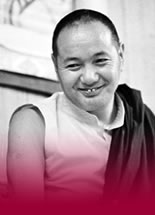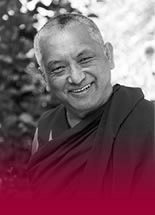Q & A with Robina
19 July, 2021
QUESTION
Dear Venerable Robina,
I remember reading Saraha’s Song for the King where he wanted to make three points clear for the Brahmin King. He said: “(1) All the things that appear to the mind are not there in reality. (2) All appearances are merely the Dharmakaya. (3) Migrating beings are merely buddhas.”
Would you agree that the world is a manifestation of the Dharmakaya, and all mind-possessors are already buddhas, they just don’t know it yet.
And Choden Rinpoche says, “When Tilopa gave Naropa the Mahamudra lineage, he told him that Mahamudra cannot be taught (we don’t investigate and come to an inference of emptiness) because it is not an object of the conceptual mind, Mahamudra is to be practiced, to be seen directly.” So this is also quite a difference, isn’t it? On the sutra path there is much conceptuality used, whereas Mahamudra seems to cut straight through conceptuality and arrive at direct experience.
It’s very interesting to see what these people have come to understand!
Sending you all the best wishes,
V
ANSWER
Happy to hear your thoughts, V.
I don’t think Lama Tsongkhapa would say that we’re already a buddha! That’s very much a Kagyu or Nyingma thing to say, coming from those amazing mahasiddhas!
I mean, an acorn is not an oak tree — try getting shade from it!
But I think it’s hugely beneficial to think that way: it powerfully counteracts the primordial instinct of the limited, miserable, separate self.
Actually, the usual mahamudra technique — watching the clarity of the mind, which leads to seeing the emptiness of the mind — is a sutra technique. But as you might have read in my Preface in Lama Yeshe’s book, Mahamudra: How to Discover Our True Nature, at the teaching in Australia in 1981 Lama first gave a Heruka Chakrasamvara empowerment (the first Highest Yoga Tantra empowerment in Australia, in fact). And at the end of the teaching Lama gave a glimpse into tantric mahamudra by teaching on inner fire.
But when we received from His Holiness the Dalai Lama in his temple in Dharamsala the following year, at the request of Lama Yeshe, the commentary on the Panchen Lama text that Lama Yeshe also used, we didn’t receive from His Holiness an empowerment.
Those teachings are included in Alex Berzin’s The Gelug/Kagyu Tradition of Mahamudra. It was marvelous! His Holiness gave a brief but clear description of every variety of dzogchen/mahamudra! You would definitely appreciate this book.
Much love and many blessings, dear V,
Robina
QUESTION
Dear Venerable Robina,
You’re right about the difference in views between Lama Tsongkhapa and the Kagyus, Nyingmas, the Chan schools. I love how the Kagyus explain it, that the wave doesn’t need to do anything to become the ocean, her very nature is already ocean water. We are already what we want to become. So the wave just needs to remove the false appearances and concepts of her as a separate wave and directly recognize the ocean.
I read one of your Q&As that included the name of the mahamudra Kagyu/Gelug manual and I found it then on Berzin’s website with a commentary by Geshe Ngawang Dhargyey.
Amazing how in your time the access to these teachings was so easy for Westerners.
I remember when I attended the online retreat with you on Green Tara, you read in one of the sessions this story about a man who found an authentic mahasiddha meditating in a cave and he told him that he is ready to renounce everything if the yogi would take him as a disciple and give him teachings. So, even further back, ordinary people would be directly and experientially taught by mahasiddhas.
I have one more question.
When actually tasting, for example, a mixture of pus, urine, shit, meat, blood etc., what experiences bliss is the mental consciousness, not the tongue sense consciousness, right?
It’s something similar to the concept of alchemy.
But the actual transforming factor of the “external” substance is the mental consciousness, and what is transformed is the perception, the concept of those substances as being defiled into the concept of them being pure. The mere transformation coming out of the emptiness of inherent existence of that substance is what gives it its new name and meaning, nectar.
It’s like re-creating a reality that we thought of as solidly and immutably defiled – and transforming it, in actuality, into something pure, blissful. Like that woman that transformed the prison into a meditation cave; however, her prison did not become a cave in actuality, whereas here the basis of imputation, the substance, eventually becomes nectar in actuality. So we start with the mental consciousness labeling it as nectar and experiencing bliss, but eventually the tongue sense consciousness experiences the same. Is this correct, or is my thinking wrong?
It’s as if usually we turn the mind to “external” objects that already have their label and function, whereas here we train in changing the label and the function of the basis (i.e. transforming shit into nectar) – first mentally, then in actuality – right?
ANSWER
Yes, V, it would be the mental consciousness that does the transforming — the relabeling — and that does, indeed, experience bliss, but for sure the sensory consciousness would experience bliss too.
The story you mention is part of the biography of Geshe Lama Konchog, who was a friend of Lama Yeshe’s at Sera Je and who spent years in the mountains of Nepal close to the border of Tibet where Milarepa meditated. He “lived in Vajra Yogini’s Pure Land” Lama Zopa Rinpoche said.
I’ve been writing this biography on behalf of Geshe-la’s main disciple, Geshe Tenzin Zopa (it’s in his voice). Geshe Lama Konchog spent years up there naked, no food, no sleep, and living on wind chulen — he was to be nourished by the air, (“take the essence” = chulen)! Makes sense — all the elements are contained in each of the four. He was pure enough to get what he needed.
But the pus for the yogi and the prison cell for Sunny — same! Of course her prison cell transformed into a cave: it fits the definition, it fulfilled the function of a cave.
Love,
Robina

